Key Documents
D3689
(S)-3,5-Dihydroxyphenylglycine hydrate
≥98% (HPLC), powder
Synonim(y):
S-DHPG
About This Item
Polecane produkty
Próba
≥98% (HPLC)
Postać
powder
warunki przechowywania
desiccated
protect from light
kolor
white
temp. przechowywania
−20°C
ciąg SMILES
O.N[C@H](C(O)=O)c1cc(O)cc(O)c1
InChI
1S/C8H9NO4.H2O/c9-7(8(12)13)4-1-5(10)3-6(11)2-4;/h1-3,7,10-11H,9H2,(H,12,13);1H2/t7-;/m0./s1
Klucz InChI
QZEFIWWBQUKNFA-FJXQXJEOSA-N
informacje o genach
human ... GRM1(2911)
Zastosowanie
- as mGluR1/5 agonist for metabotropic glutamate receptor 1 (mGluR1/5) activation in synaptoneurosomal preparations
- in ACSF for DHPG stimulation
- to inject into basolateral amygdala to study its effect on memory expression
Działania biochem./fizjol.
Cechy i korzyści
Przestroga
Hasło ostrzegawcze
Warning
Zwroty wskazujące rodzaj zagrożenia
Zwroty wskazujące środki ostrożności
Klasyfikacja zagrożeń
Eye Irrit. 2 - Skin Irrit. 2 - STOT SE 3
Organy docelowe
Respiratory system
Kod klasy składowania
11 - Combustible Solids
Klasa zagrożenia wodnego (WGK)
WGK 3
Temperatura zapłonu (°F)
Not applicable
Temperatura zapłonu (°C)
Not applicable
Środki ochrony indywidualnej
dust mask type N95 (US), Eyeshields, Gloves
Certyfikaty analizy (CoA)
Poszukaj Certyfikaty analizy (CoA), wpisując numer partii/serii produktów. Numery serii i partii można znaleźć na etykiecie produktu po słowach „seria” lub „partia”.
Masz już ten produkt?
Dokumenty związane z niedawno zakupionymi produktami zostały zamieszczone w Bibliotece dokumentów.
Klienci oglądali również te produkty
Nasz zespół naukowców ma doświadczenie we wszystkich obszarach badań, w tym w naukach przyrodniczych, materiałoznawstwie, syntezie chemicznej, chromatografii, analityce i wielu innych dziedzinach.
Skontaktuj się z zespołem ds. pomocy technicznej









